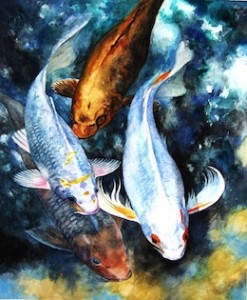Art in the Scholars’ Lab
The first time I walked into the Scholars’ Lab, I was amazed by the space. With the high ceilings, black-and-white tile floors, and the bold red wall, it looked like something out of a magazine, not a computer lab at UVA!
I’ve been at UVA for a long, long time and I’ve worked in some nice, if a little traditional, spaces. But the Scholars’ Lab is the first place I’ve worked that has been so modern and energetic. The décor is a direct result of the purpose of the space: energy, synergy, and creativity. So it was no surprise to me that Bethany aspired to have the art in the Scholars’ Lab as dynamic as the rest of the environment. In the spring of 2008, when I was new to the Scholars’ Lab and Bethany had been the director for less than a year, we set out to change our walls from hosting a set of functional, framed posters to a rotating art show.
Art from Erin Chilton’s show.
In the late spring of 2008, Erin Chilton, a 4th year student with an exhibit of beautiful, realistic paintings, shared her art in our space. The following fall, our own Digital Humanities Graduate Fellow, Jean Bauer, contributed several lovely color photographs. They were beautiful in their simplicity. We kept them up throughout the school year.
We hosted our first Aunspaugh Fellow in the fall of 2009. (An Aunspaugh Fifth Year Fellowship enables a U.Va. student who has an undergraduate degree to spend a year of intensive effort in a studio area within the McIntire Department of Art.) Jeff Trueblood’s dark paintings filled every wall with their bold, haunting beauty. Jeff’s talent for creating an atmosphere with light and dark still excites my curiosity. Taking a flashlight to one of his pieces will illuminate what is beneath the trees or behind the lamppost.
We tried something different in the spring of 2010, opting for architectural renderings of Alderman Library. Students in the School of Architecture’s graduate Architecture Studio 6020 were assigned a project to re-vision Alderman’s West Wing as a catalyst for new learning environments. Their large pieces and a few 3-D models were hung throughout the Scholars’ Lab for the spring semester and gave all of us interesting points to consider for the future of our beloved building.
In the fall of 2010, Aunspaugh Fellow Emily Corazon Nelson shared a series called “Nourish(ment)”. Emily’s use of collage, staining, painting, and lamination with her photography created a dynamic show in the Scholars’ Lab. Her work was inspired by an earlier project in which she and a few friends ran a garden and kitchen out of a biofuel bus and traveled around America, feeding people and developing relationships, while asking “what does nourishment mean to you?” More of Emily’s art is here.
Daniel Ballard’s work in paper making, printing, watercolor, and collage became, in the spring of 2011, a subtle exhibit of colors and forms to represent cityscapes and nature. At the core of the show was Dan’s exploration into the implications of proposals for the future of cities.
In Fall 2011, we showcased a small exhibit by Bena Dam, another Aunspaugh Fellow. Bena’s photographs were beautiful, challenging and, in some ways, frightening. Her goal was “to inject both a sense of whimsy and discomfort in [her] art.” Her piece called “Hair Sew” (in which she sewed her fingers together with a strand of her own hair) and “Hung Up” (an optical illusion of Bena, headless, hanging by a wire hanger in her empty closet) were more startling than some might have liked, but personally I loved them because they did exactly what Bena set out to do: create feelings of discomfort and whimsy.
Last spring, Takahiro Suzuki shared his black-and-white photographs in an exhibit he called “Beauty Through the Stillness”. Taka’s goal was to highlight the barrenness of winter landscapes, while challenging the viewer to see the beauty in the quiet, desolate images. They were at times dark, but not heavy, and I especially enjoyed the surprise of noticing a cemetery in one image after having looked at it repeatedly without noticing it.
Our current exhibit is by Aunspaugh Fellow Elisabeth Hogeman. Ellie named her exhibit “Meander Lines,” an homage to map-making and ecology. Ellie’s primary idea in her photographs is to, in her words, “play with the idea of the female body as a natural form, making contained topographical landscapes out of the body, set alongside areas of uncontained dense vegetation located near sources of water.” Her art is beautiful, soft, and unflinching. As with our previous art exhibits, “Meander Lines” fits well into our Scholars’ Lab space because it is as dynamic, creative, and bold as the Scholars’ Lab itself.
Every semester we are challenged to think again about our surroundings, ourselves, our fears, and our hopes – kind of like every semester for our students! I can’t wait to unveil our new exhibit (yet to be determined) soon. Stay tuned!

